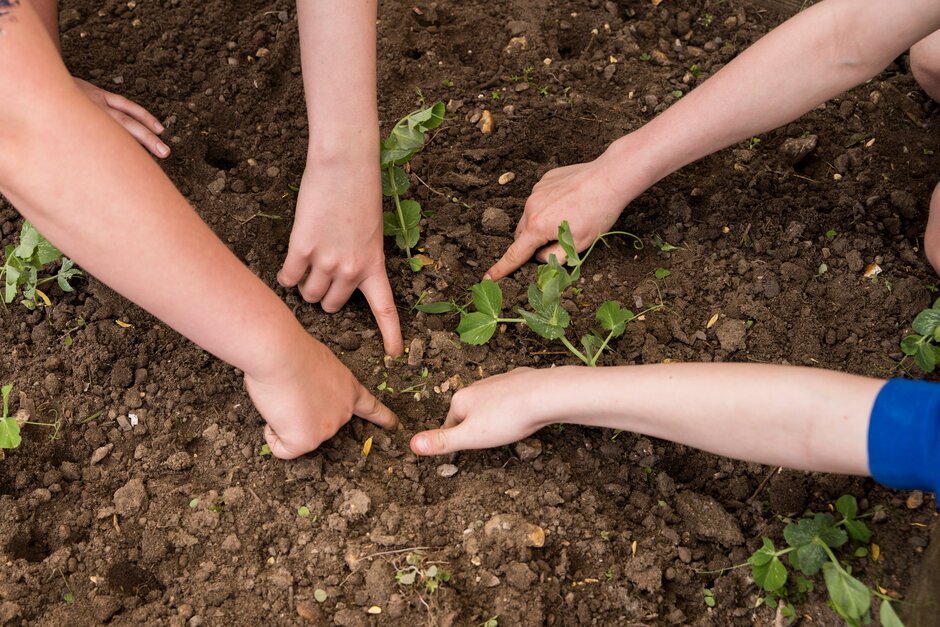Communication and language
Communication is a crucial skill when making positive environmental change. It enables learners to express their ideas and work together as a team. Nature Park EYFS Continuous provision provides a great opportunity for learners to pick up new vocabulary in context and explore different concepts with their peers. Spending time outdoors and in nature encourages quality communication between learners as they are more cooperative and creative.
Adult-led activity suggestions
- A way for learners to connect with nature even when their grounds may have limited green space is to look up to the sky and take part in cloud gazing. Whilst observing the clouds, learners can use their imaginations to spot objects and characters. During the discussion phase, facilitators can use ‘I wonder’ statements to think about the role of clouds and discuss the amount and type of clouds they see in different seasons and the effect they have on the weather.
- Encourage learners to listen and respond to peers using natural objects from their setting to use as talking tokens. This can be used to help learners express their emotions and empathise with others.
- Barefoot sensory safari supports connection with the natural world by inviting children to take a walk around the grounds barefoot. Encourage learners to comment on the different textures, smells and sounds that the ground makes.
- Nature Park activity: Sound mapping - this activity encourages children and young people to use their sense of hearing to make a sound map of an outdoor space, taking notice of what they can hear and where it is coming from.
Continuous provision: Soil creation station
Creating healthy soil is a fun and exploratory activity that can take learning in many directions. When thinking about caring for the planet and those that live on it, soil has a huge impact. Through inquiry and play, learners can explore what healthy soil is and begin to understand the important role it plays in a healthy environment. Allow learners to touch, smell, and look at soil before prompting them to think about and discuss what it is made up of. Most soils are a mixture of decomposed organic matter, insects, rock particles, water, air, dead plants and animals. Introduce the concept of worms eating dead things in nature and turning them into soil. Discuss what other things we might find in soil. Some possible answers from learners may include:
- Sand
- Clay
- Mud
- Leaves
- Bark
- Rocks
- Bugs
- Chalk
- Leaves
- Flowers
- Compost
- Water
Introduce to the group that you will set up a soil inquiry and each pair will need to choose their own ingredients to make up a soil mixture and compete to see which soil a seed will thrive most in. In pairs, learners should discuss which items they would like to place in their soil potion. They will all begin with a cup of compost, described as soil made by worms. They can then add three other items to their potion. Once the pair are both happy with their soil potions, they can place them in a sunlit spot and sew their seed. In front of their pots, they should be supported to write a list of ingredients that went into their pot. Remind the learners to spray with water each day and in one week compare the seed growth. Ensure the pots receive an equal amount of sun and water to ensure a comparative test is carried out. The soil creation station can remain open for learners to explore the different elements and textures.
Green skill development
- Identification and ecology
- Decision making and creative thinking
- Environmental stewardship and horticulture
- Communication

© RHS, Credit: RHS / Georgi Mabee
Early learning goal outcomes
- Listen attentively and respond to what they hear with relevant questions, comments and actions when being read to and during whole class discussions and small group interactions;
- Make comments about what they have heard and ask questions to clarify their understanding;
- Hold conversation when engaged in back-and-forth exchanges with their teacher and peers.
- Participate in small group, class and one-to-one discussions, offering their own ideas, using recently introduced vocabulary.
- Offer explanations for why things might happen, making use of recently introduced vocabulary from stories, non-fiction, rhymes and poems when appropriate.
- Express their ideas and feelings about their experiences using full sentences, including use of past, present and future tenses and making use of conjunctions, with modelling and support from their teacher.